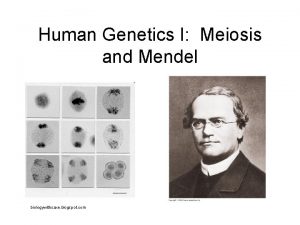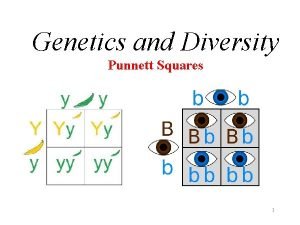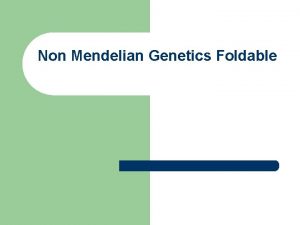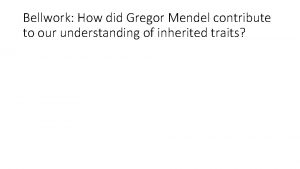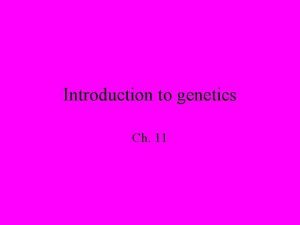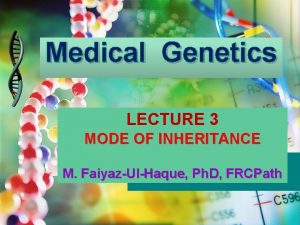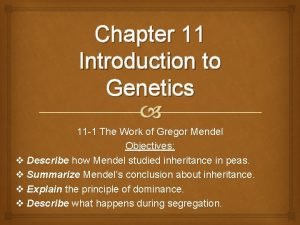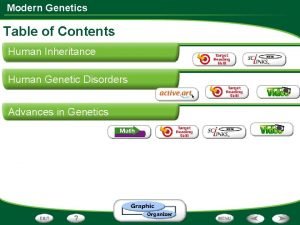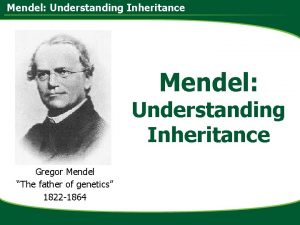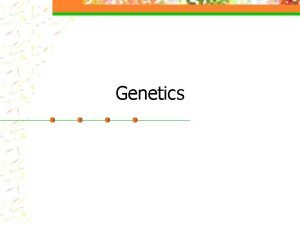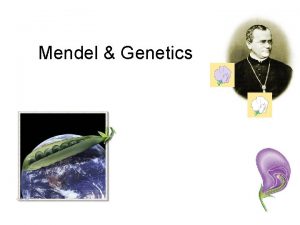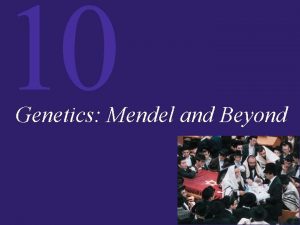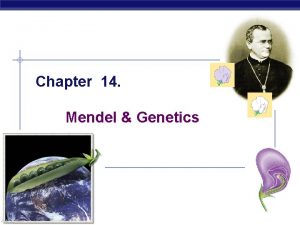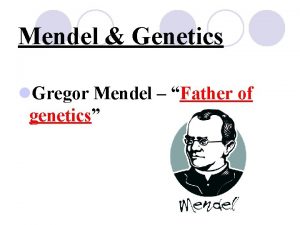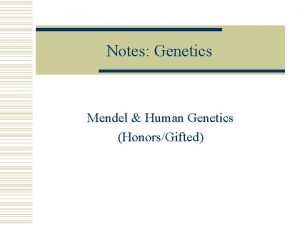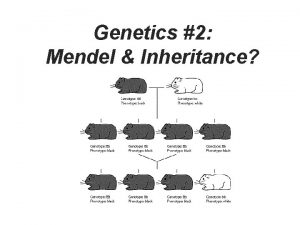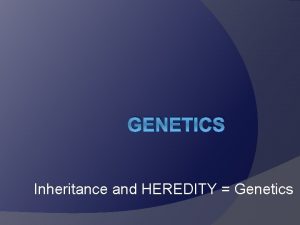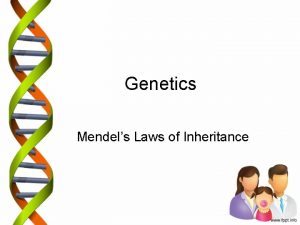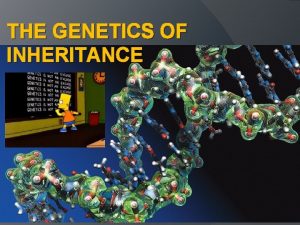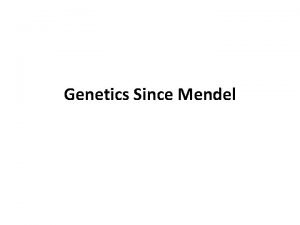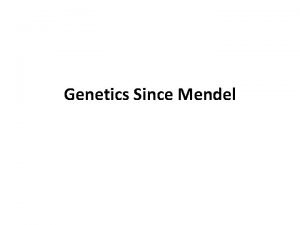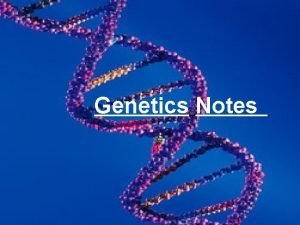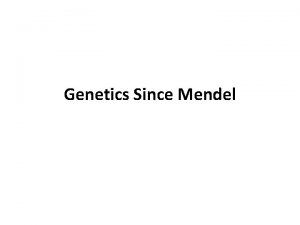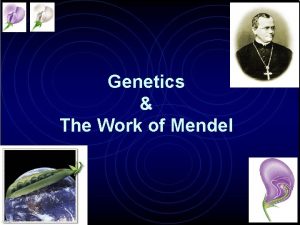Genetics 2 Mendel Inheritance What is Inheritance Most


































- Slides: 34

Genetics #2: Mendel & Inheritance?

What is Inheritance? • Most people think about inheriting money from a relative who has died. • But, we’re going to learn about another form of inheritance…. GENES!

What has genes? • Genetics is the scientific study of heredity, or where we get our genes from and how. • Every living thing has genes, they are responsible for certain sets of characteristics which get passed from the parent(s) to the offspring.

Who discovered Genetics? • Gregor Mendel discovered genetics. – Austrian monk – Went to school for science and math – Taught high school – Was in charge of the monastery garden • He started playing with garden pea plants and discovered different modes of inheritance

What he knew • Part of each pea plant produces pollen which contains the male reproductive cells, sperm. • The female portion of the plant produces egg cells. • During sexual reproduction the male and female reproductive cells join, this is called fertilization.

• The result of fertilization is a tiny embryo within a seed. • Pea flowers are normally self-pollinating which means that the pollen from the flower normally fertilizes the egg in the same flower • The seeds produced from a self-pollinating plant bear all the characteristics of their parent plant, therefore they have a single parent.

Here comes Mendel! • When Mendel took over the monastery garden there were several types of pea plants. • They produced different characteristics like tallness, shortness, green seeds and yellow seeds. • The plants were true-breeding, which means if they were allowed to self-pollinate they would produce offspring identical to themselves


• Mendel wanted to produce seeds by joining male and female sperm and eggs from different pea plants. • Mendel started crosspollinating. He started by cutting off the pollen-bearing male parts in a pea flower, then he dusted pollen from another plant onto the flower. This produces seeds with 2 different parents.


• A trait is a characteristic like seed color or plant height that varies from one individual to another. • Mendel studied the effects of crossing 7 plants with different traits. • The original plants are called the P (parental) generation and the offspring are called F 1 (first filal or “son”) • The offspring of crosses with different parents are called hybrids.

Results from the cross • Were the F 1 generation plants a blended mix of both parents’ characteristics? NO! • It turns out the F 1 generation plants had either the characteristic of one parent OR the other, but not both!

Mendel’s 2 Conclusions 1. Biological inheritance is determined by factors that are passed from one generation to the next. • We call the chemical factors that determine traits, genes. • Each trait Mendel studied was controlled by one gene that occurred in 2 contrasting forms • The different forms of a gene are called alleles.

Mendel’s 2 Conclusions 2. The principle of dominance states that some alleles are dominant while others are recessive. • An organism with the dominant form of a trait will always exhibit that form of the trait. An organism with the recessive form of the trait will exhibit it only if the dominant trait is NOT present.

Segregation • Mendel wondered, “have the recessive alleles disappeared or are they still present in the F 1 generation? ” • He allowed F 1 generation to self-pollinate and produce an F 2 generation shown below:

What he discovered… • When the F 1 generation was allowed to self-pollinate the recessive alleles reappeared in the F 2 generation! • So why did the recessive alleles seem to disappear in the F 1 generation? Let’s take a closer look.

Turns out… • The alleles segregate from each other during gamete formation when crossingover occurs so that each gamete carries only a single copy of each gene. • Each F 1 plant produces 2 types of gametes– those with the allele for tallness and those with the allele for shortness.

• Crossing over - during meiosis, when homologous chromosomes are paired together, there are points along the chromosomes that make contact with the other pair. • These points of contact can allow the exchange of genetic information between chromosomes.

Crossing over occurs during prophase I and means that each daughter cell formed in meiosis has chromatids with a different combination of alleles.

Probability and Punnett Squares • Mendel discovered that the principles of probability could be used to explain results of genetic crosses – Example: He realized every time he crossed 2 plants hybrid for stem height (Tt), about ¾ of offspring were tall and ¼ were short! • The gene combinations that might result from a genetic cross can be determined by drawing a punnett square. Punnett squares can be used to predict and compare the genetic variations that will result from cross.

Punnett Square • The gametes produced by each F 1 parent are along the top and left side of the square. The possible gene combinations for the F 2 generation appear in the 4 boxes that make up the square. – The letters in the boxes represent alleles, T is the dominant allele for tallness and t is the recessive allele for shortness

remember • Organisms that have 2 identical alleles for a particular trait are called homozygous (TT or tt). – True-breeding • Organisms that have 2 different alleles for a particular trait are called heterozygous (Tt). – Hybrid

Break it down… • All of the tall plants have the same phenotype, or physical characteristics. • But, they do not have the same genotype, or genetic makeup. • This makes the ratio of tall to short plants 3: 1

Independent Assortment • Mendel performed a two-factor cross • He first crossed true-breeding plants that produced only round yellow (RRYY) peas with plants that produced wrinkled green peas (rryy) • All F 1 offspring are round yellow peas, showing those are the dominant alleles (Rr. Yy)

What’s Next? • Mendel knew all F 1 plants were heterozygous for both seed shape and color (Rr. Yy) • F 1 s were crossed with each other to produce F 2 generation • Independent allele segregation resulted

F 2 generation results • The F 2 plants produced 566 seeds. – 315 seeds were round and yellow – 32 seeds were wrinkled and green – 209 seeds had combinations of the phenotypes • Independent assortment occurred. The alleles for seed color and shape segregated independently. • The results were close to a 9: 3: 3: 1 ratio

Independent Assortment • The principle of independent assortment states that genes for different traits can segregate independently during the formation of gametes. • Independent assortment helps account for the many genetic variations observed in plants, animals and other organisms.

Summary of Mendel’s Principles • Inheritance of biological characteristics is determined by genes • In cases where 2 or more alleles of a gene for a single trait exist, some are dominant and some are recessive • Most parents have 2 copies of a single gene which segregate when gametes are formed • Alleles for different genes usually segregate independently of one another

It’s not black and white • Some alleles are neither dominant nor recessive, and many traits are controlled by multiple alleles or multiple genes – Incomplete dominance- cases in which one allele is not completely dominant over another (blended phenotype) – Codominance- both alleles contribute to the phenotype (spotty or checkered phenotype)

Its not black & white – Multiple Alleles- more than 2 alleles which when they segregate can result in a wider variation of phenotypes (bunny fur color, blood type) – Polygenic traits- traits controlled by 2 or more genes (human skin color)

• The characteristics of any organism are not determined solely by the genes it inherits. • The characteristics are determined by interaction between genes and the environment – Genes may affect a sunflower’s color and height, but the same factors are also influenced by climate, soil conditions and the availability of water

YOUR TURN! • Fill out the punnett square at the bottom of your notes. • We will review the answers together! #1 – Flower petal colors

http: //www. youtube. com/watch? v=d 4 iz. VAkh. MPQ&feature=related Your Turn Answers

#2 Can you predict chin shape? • 2 parents with cleft chins, both heterozygous for cleft chin (Tt) have 3 children with cleft chins. What is the probability that a fourth child will have a cleft chin? • Fill in a punnett square to determine the possible phenotype for the fourth child
 Meiosis
Meiosis Genetics since mendel
Genetics since mendel Gregor mendel
Gregor mendel Blue eye phenotype
Blue eye phenotype Chapter 11 biology test
Chapter 11 biology test Mendel's genetics foldable
Mendel's genetics foldable How did gregor mendel contribute to genetics
How did gregor mendel contribute to genetics Solid
Solid Mendel monk
Mendel monk 3 laws of inheritance
3 laws of inheritance Mendel's first and second law of inheritance
Mendel's first and second law of inheritance X linked dominant punnett square
X linked dominant punnett square Punnett square
Punnett square What did mendel conclude determines biological inheritance
What did mendel conclude determines biological inheritance Chromosomes and alleles
Chromosomes and alleles Genetics graphic organizer
Genetics graphic organizer Modern genetics human inheritance answer key
Modern genetics human inheritance answer key Human inheritance modern genetics answer key
Human inheritance modern genetics answer key In the name of allah the most beneficent the most merciful
In the name of allah the most beneficent the most merciful Aqeedah
Aqeedah In the name of allah the most gracious the most merciful
In the name of allah the most gracious the most merciful What is the world record for reading words per minute
What is the world record for reading words per minute Crayfish taxonomy
Crayfish taxonomy In the name of allah the beneficent the merciful in arabic
In the name of allah the beneficent the merciful in arabic In the name of god the most gracious the most merciful
In the name of god the most gracious the most merciful In the name of allah the most beneficent the most merciful
In the name of allah the most beneficent the most merciful Arrangement of organisms
Arrangement of organisms Most general to most specific classification
Most general to most specific classification In the name of god most gracious most merciful
In the name of god most gracious most merciful Allah the most beneficent
Allah the most beneficent Ponceau pronunciation
Ponceau pronunciation In the name of god, most gracious, most merciful prayer
In the name of god, most gracious, most merciful prayer Most general to most specific classification
Most general to most specific classification To infinity and beyond latin
To infinity and beyond latin Genotype punnett square example
Genotype punnett square example
